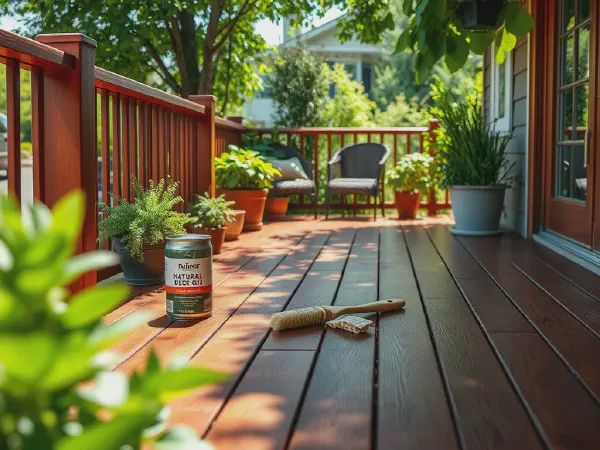The Ultimate Guide to Maintaining Your Decking with Oil

A Complete Guide to Deck Maintenance
Deck Maintenance is essential for preserving the beauty and functionality of your outdoor wooden structures. Regular upkeep not only enhances the appearance of your deck but also prolongs its lifespan, making it a valuable investment for your home. In this article, we will cover various aspects of deck maintenance, including the importance of oiling, application techniques, and troubleshooting common issues.
One of the primary components of effective Deck Maintenance is selecting the right decking oil. The right oil will not only protect the wood from external elements but also enhance its natural beauty. With various options available, homeowners must understand their specific decking material and the environment it is exposed to, ensuring the longevity and resilience of their deck.
Another critical aspect of Deck Maintenance is the application techniques for oil. Proper application ensures that the oil penetrates the wood effectively, providing adequate protection against moisture, UV rays, and other damaging factors. This article provides a step-by-step guide on how to prepare and apply decking oil correctly while highlighting common mistakes to avoid.
The benefits of oiling your deck cannot be overstated. In addition to protecting the wood from weather damage, regular oiling enhances the natural grain and color of the wood, making it more visually appealing. Furthermore, it prevents mold and mildew growth, contributing to a safer and healthier outdoor space for you and your family.
To keep your deck looking its best, it’s crucial to understand the maintenance frequency required for oiled decks. Knowing how often to oil your deck, recognizing signs that it needs re-oiling, and implementing seasonal maintenance tips are all essential for long-term care. By following the right strategies, you can ensure that your deck remains in excellent condition for years to come.
Choosing the Right Decking Oil
There are several types of decking oils available, including transparent, semi-transparent, and solid colors. Transparent oils allow the natural wood grain to show through, while semi-transparent ones offer more color while still showcasing the grain. Solid-color oils provide the most protection and color but obscure the wood’s natural look. Knowing the difference will help you choose the right oil for your specific needs.
Factors to consider when selecting oil include the type of wood, the deck's exposure to sunlight and moisture, and your aesthetic preferences. For example, hardwoods like teak and mahogany may require different oils than softwoods like pine or cedar. Additionally, harsh climates may necessitate a more robust oil formulation for better protection.
Eco-friendly decking oil options are gaining popularity among environmentally conscious homeowners. These oils are formulated using natural ingredients and tend to be free of harmful solvents and chemicals. When considering eco-friendly options, look for products that are biodegradable and have minimal environmental impact without compromising performance.
Before applying oil to your deck, it’s essential to test compatibility with your decking material. To do this, choose a small, inconspicuous area on your deck, apply the oil as per the manufacturer's instructions, and observe how it interacts with the wood. Check for any adverse reactions like discoloration or peeling before proceeding with full application.
Application Techniques for Decking Oil
Preparing your deck for oil application is crucial for achieving the best results. Start by cleaning the deck thoroughly to remove dirt, mildew, and previous coatings. A power washer can be effective for deep cleaning, but ensure the wood is dry before applying oil. Sand any rough spots to ensure an even application, and check for repairs that may need to be addressed.
Tools needed for oil application include a high-quality brush or roller, a paint tray, rags for cleanup, and protective gear such as gloves and eyewear. Additionally, having a drop cloth can help protect surrounding areas from drips or spills during the application process.
A step-by-step guide to applying decking oil includes the following steps: First, ensure the deck is clean and dry. Next, pour the oil into the paint tray and use the brush or roller to apply it evenly across the deck boards. Work in sections, allowing the oil to soak in for about 10-15 minutes before wiping off any excess. Finally, let the deck dry completely according to the manufacturer’s instructions before use.
Common mistakes to avoid while oiling include applying the oil in direct sunlight, which can cause it to dry too quickly, leading to uneven absorption. Additionally, failing to clean the deck adequately beforehand can result in poor adhesion and a patchy finish. Lastly, over-application can lead to a sticky surface that attracts dirt and debris.
Benefits of Oiling Your Deck
Oiling your deck protects against weather damage such as moisture and UV rays. The oil creates a barrier that prevents water from penetrating the wood, reducing the risk of warping, cracking, and splitting. This barrier also protects against harmful UV rays that can cause color fading and deterioration over time.
In addition to protection, oiling enhances the wood's natural beauty. Oiling brings out the grain patterns and color variations in the wood, giving your deck a stunning appearance that can elevate the overall look of your outdoor space. This aesthetic value makes regular oiling a worthwhile investment.
Oiling your deck also prevents mold and mildew growth, which can thrive in damp, untreated wood. Regular oiling creates a less hospitable environment for these fungi, keeping your deck safer for family gatherings and outdoor activities. This proactive measure is especially important in humid climates.
Finally, the longevity benefits of regular oiling are significant. By maintaining your deck through consistent oil application, you can extend its lifespan, reducing the need for costly repairs or replacements down the line. An oiled deck is a durable deck, ensuring your outdoor space remains functional and beautiful for years to come.
Maintenance Frequency for Oiled Decks
How often should you oil your deck? Generally, you should plan to reapply oil to your deck every 6 to 12 months, depending on factors such as climate, wood type, and usage. High-traffic areas or decks in direct sunlight may require more frequent oiling to maintain optimal protection and appearance.
Signs your deck needs re-oiling include fading color, rough texture, and water absorption. Conduct a simple test by pouring a small amount of water on the surface; if it beads up, the oil is still effective. If it soaks in, it’s time to apply a new coat of oil.
Seasonal maintenance tips include cleaning the deck thoroughly before winter and re-oiling after any significant weather events, such as heavy rain or snow. Regular inspections for signs of wear and tear are also crucial to address minor issues before they become major problems.
Long-term care strategies for oiled decks involve creating a routine maintenance schedule that includes cleaning, oiling, and inspections. Keeping track of when each maintenance task is completed can help you stay organized and ensure your deck remains in excellent condition for years to come.
Troubleshooting Deck Maintenance Issues
Dealing with peeling or flaking oil can be frustrating. This issue often arises from poor application techniques or the use of incompatible products. To address this, remove the affected areas using a deck cleaner and sand them down before reapplying the oil to achieve a uniform finish.
Repairing damaged sections of the deck may require replacing boards or filling in gaps with appropriate materials. Ensure that any repairs are done using compatible wood and finishes to prevent further issues. Regular inspections can help you catch damage early before it necessitates extensive repairs.
Identifying and treating wood rot is crucial for the longevity of your deck. Look for soft, spongy areas and dark spots. If rot is detected, you might need to replace the affected sections. Additionally, treating the wood with a suitable preservative can help prevent future rot.
Preventative measures for decking issues include regular maintenance, such as cleaning and oiling, as well as proper drainage to prevent water pooling. Ensuring that your deck is adequately ventilated also helps reduce moisture buildup, which can lead to many potential problems.
